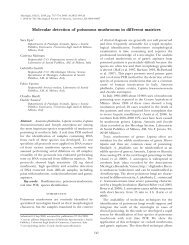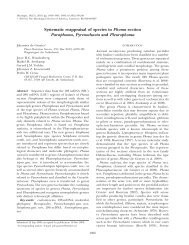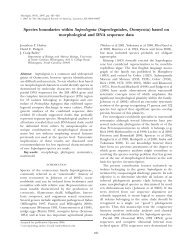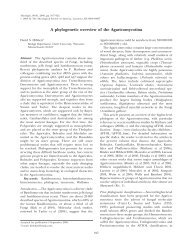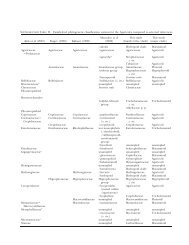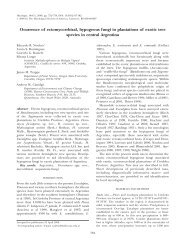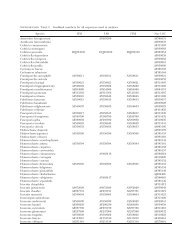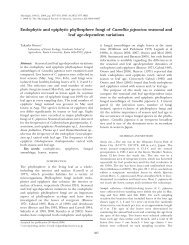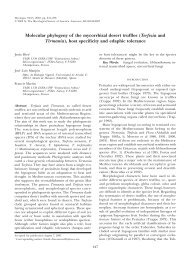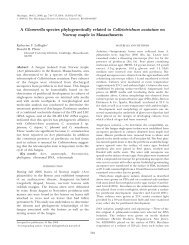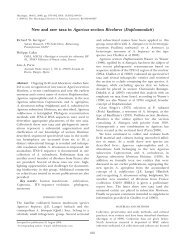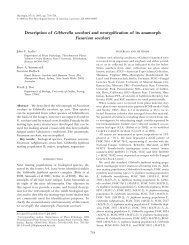Two new species of Appendiculella (Meliolaceae) from ... - Mycologia
Two new species of Appendiculella (Meliolaceae) from ... - Mycologia
Two new species of Appendiculella (Meliolaceae) from ... - Mycologia
Create successful ePaper yourself
Turn your PDF publications into a flip-book with our unique Google optimized e-Paper software.
<strong>Mycologia</strong>, 99(4), 2007, pp. 544–552.<br />
# 2007 by The Mycological Society <strong>of</strong> America, Lawrence, KS 66044-8897<br />
<strong>Two</strong> <strong>new</strong> <strong>species</strong> <strong>of</strong> <strong>Appendiculella</strong> (<strong>Meliolaceae</strong>) <strong>from</strong> Panama<br />
Délfida Rodríguez J.<br />
Meike Piepenbring<br />
Institute <strong>of</strong> Ecology, Evolution and Diversity,<br />
J.W. Goethe-Universität Frankfurt am Main,<br />
60054 Frankfurt am Main, Germany<br />
Abstract: <strong>Two</strong> <strong>new</strong> <strong>species</strong> <strong>of</strong> <strong>Meliolaceae</strong> (black<br />
mildews) are described based on specimens recently<br />
collected in western Panama. <strong>Appendiculella</strong> lozanellae<br />
on leaves <strong>of</strong> Lozanella enantiophylla is the first <strong>species</strong><br />
<strong>of</strong> <strong>Appendiculella</strong> known on Cannabaceae. <strong>Appendiculella</strong><br />
chiriquiensis on leaves <strong>of</strong> Cupania guatemalensis<br />
is the first record <strong>of</strong> a <strong>species</strong> <strong>of</strong> <strong>Appendiculella</strong> on<br />
Sapindaceae. These <strong>species</strong> differ <strong>from</strong> known <strong>species</strong><br />
on their respective host relationships by the presence<br />
<strong>of</strong> larviform appendages attached to the perithecia, as<br />
well as by characteristics <strong>of</strong> hyphae, appresoria and<br />
ascospores. Sequence data <strong>of</strong> 18S and 28S rDNA are<br />
published for A. lozanellae, which becomes the third<br />
<strong>species</strong> <strong>of</strong> Meliolales and the first <strong>species</strong> <strong>of</strong> the genus<br />
<strong>Appendiculella</strong> for which molecular data are available.<br />
Key words: Cannabaceae, Cupania guatemalensis,<br />
Lozanella enantiophylla, plant parasitic fungi, Sapindaceae,<br />
systematics, taxonomy, Ulmaceae<br />
INTRODUCTION<br />
Species <strong>of</strong> <strong>Meliolaceae</strong> (about 1583 <strong>species</strong> in 20<br />
genera, Kirk et al 2001; Meliolales, Ascomycota) are<br />
tropical plant parasitic fungi infecting plant <strong>species</strong><br />
belonging to numerous families. Because <strong>of</strong> their<br />
dark color and their growth on leaves and stems they<br />
are called black mildews or dark mildews. They are<br />
characterized by superficial, dark, thick-walled,<br />
branching hyphae with appresoria and conidiogenous<br />
cells. Appresoria adhere to the cuticle <strong>of</strong> leaves <strong>of</strong><br />
the host, penetrate the host cell wall and form<br />
haustoria inside the host cell. Conidiogenous cells<br />
(also called mucronate hyphopodia) are phialides<br />
and produce rarely observed small spores <strong>of</strong> unknown<br />
function. These spores might contribute to asexual<br />
multiplication or sexual reproduction (Luttrell 1989,<br />
Mueller et al 1991). Attempts to grow <strong>species</strong> <strong>of</strong><br />
<strong>Meliolaceae</strong> in culture have not succeeded. In<br />
addition to appresoria and conidiogenous cells, the<br />
dark hyphae develop superficial, dark perithecia<br />
Accepted for publication 22 June 2007.<br />
1 Corresponding author. E-mail: delfidaro@yahoo.es<br />
544<br />
containing clavate asci with thin walls. Asci typically<br />
contain two brown ascospores with four septa each.<br />
Setae can be attached to hyphae (Meliola) or can<br />
arise <strong>from</strong> perithecia (Irenopsis). The position <strong>of</strong><br />
setae, wall structure and tips are morphologically<br />
diverse among <strong>species</strong> <strong>of</strong> <strong>Meliolaceae</strong>. Therefore<br />
details <strong>of</strong> position and structure <strong>of</strong> setae are important<br />
tools to distinguish genera and <strong>species</strong>. Species <strong>of</strong><br />
the <strong>Meliolaceae</strong> traditionally have been assigned to<br />
one <strong>of</strong> four genera on the basis <strong>of</strong> presence or<br />
absence <strong>of</strong> setae and their form and location. Setae <strong>of</strong><br />
Meliola Fries, the largest genus <strong>of</strong> <strong>Meliolaceae</strong> with<br />
about 1000 <strong>species</strong>, are attached to hyphae (mycelial<br />
setae). Setae <strong>of</strong> Irenopsis F. Stevens (ca. 50 <strong>species</strong>)<br />
arise <strong>from</strong> perithecia. Species <strong>of</strong> Asteridiella McAlpine<br />
(ca. 250 <strong>species</strong>) lack setae, and <strong>species</strong> <strong>of</strong> <strong>Appendiculella</strong><br />
Höhn. (ca. 250 <strong>species</strong>) have perithecia with<br />
larviform appendages (Hansford 1961, Kirk et al<br />
2001). Larviform appendages differ <strong>from</strong> setae, being<br />
aseptate and having thin, light brown, transversely<br />
striate walls. The genus <strong>Appendiculella</strong> was proposed<br />
by Höhnel (1919, type <strong>species</strong> A. calostroma [Desm.]<br />
Höhnel on Rubus fruticosus L. [Rosaceace]) to<br />
separate <strong>species</strong> <strong>of</strong> Irene Theiss. & P. Syd. (today<br />
a synonym <strong>of</strong> Asteridiella) with larviform appendages<br />
<strong>from</strong> <strong>species</strong> without appendages.<br />
Species <strong>of</strong> the <strong>Meliolaceae</strong> traditionally have been<br />
defined as being specific to host family (Hansford<br />
1961). This hypothesis has never been analyzed<br />
critically but is workable and likely to be adequate<br />
because <strong>species</strong> <strong>of</strong> <strong>Meliolaceae</strong> interact with living<br />
cells <strong>of</strong> the plants. This biotrophic process requires<br />
specific physiological and molecular interactions.<br />
Observations in the field show that <strong>species</strong> <strong>of</strong> black<br />
mildews infect <strong>species</strong> <strong>of</strong> a single genus or <strong>of</strong> closely<br />
related genera belonging to the same family (Rodríguez<br />
2001; pers obs). For example Meliola mangiferae<br />
Earle is known growing on leaves <strong>of</strong> two <strong>species</strong> <strong>of</strong><br />
the genus Mangifera (Anacardiaceae) (viz. Mangifera<br />
indica L. [Amboin, Brunei, China, Colombia, Costa<br />
Rica, Cuba, Dominican Republic, Guyana, Honduras,<br />
India, Indonesia, Jamaica, Java, Malaysia, Panama,<br />
Papua New Guinea, Peru, Philippines, Puerto Rico,<br />
Singapore, Surinam, Taiwan, Trinidad and Tobago,<br />
Venezuela, Virgin Islands fide Hansford 1961,<br />
Schmiedeknecht 1989, Rodríguez and Minter 1998,<br />
Farr et al 2006] and M. andamica Kinq. [Andaman<br />
Islands fide Farr et al 2006]). But this <strong>species</strong> grows<br />
also on leaves <strong>of</strong> Anacardium occidentale L. (Anacardiaceae)<br />
in Costa Rica and Panama (Farr et al 2006).<br />
On the other hand <strong>species</strong> <strong>of</strong> <strong>Meliolaceae</strong> are known
RODRÍGUEZ AND PIEPENBRING: NEW APPENDICULELLA SPECIES 545<br />
to infect only one host <strong>species</strong> (e.g. Meliola anacardii<br />
Zimm. on leaves <strong>of</strong> Anacardium occidentale L. in<br />
Brunei, Costa Rica, Cuba, Dominican Republic,<br />
Guyana, India, Malasia, Philippines fide Hansford<br />
1961, Farr et al 2006).<br />
Some <strong>species</strong> <strong>of</strong> <strong>Meliolaceae</strong> infect plants belonging<br />
to a wide range <strong>of</strong> genera within a given, large<br />
family. Meliola bicornis Wint. for example has been<br />
reported <strong>from</strong> <strong>species</strong> <strong>of</strong> 29 genera <strong>of</strong> the Fabaceae<br />
(Rodríguez 2006). Other <strong>species</strong> are known only <strong>from</strong><br />
one or a few host <strong>species</strong>. Few <strong>species</strong> are reported<br />
<strong>from</strong> members <strong>of</strong> different families (Hansford 1961),<br />
but these reports have not been subjected to a critical<br />
revision.<br />
DNA sequence data will help to resolve the<br />
significance <strong>of</strong> host specificity to <strong>species</strong> delimitation.<br />
Although mycologists in several laboratories tried to<br />
isolate DNA <strong>from</strong> <strong>Meliolaceae</strong> (e.g. D. Triebel pers<br />
comm) only a few attempts have been successful.<br />
Because no cultures exist cells must be taken <strong>from</strong><br />
leaves that frequently are contaminated by numerous<br />
other fungi. The dark pigment <strong>of</strong> the thick cell walls<br />
also might interfere during the isolation <strong>of</strong> DNA.<br />
Only Saenz and Taylor (1999) have published<br />
sequence data for <strong>Meliolaceae</strong>, analyzing the phylogenetic<br />
relationship between Meliola and other<br />
ascomycetous fungi. They published the two existing<br />
sequences <strong>of</strong> 18S rDNA <strong>of</strong> <strong>species</strong> <strong>of</strong> <strong>Meliolaceae</strong><br />
available in GenBank belonging to Meliola juddiana<br />
F. Stevens and M. niessleana Wint. After numerous<br />
attempts we obtained sequence data for a third<br />
<strong>species</strong> <strong>of</strong> <strong>Meliolaceae</strong>, the <strong>new</strong> <strong>species</strong> <strong>Appendiculella</strong><br />
lozanellae.<br />
In a monumental work Hansford (1961, 1963)<br />
presented descriptions and illustrations <strong>of</strong> all thenknown<br />
<strong>species</strong> <strong>of</strong> Meliolales. Many <strong>species</strong> were added<br />
later, especially for India (e.g. Katumoto and Hosagoudar<br />
1989, Hosagoudar et al 1994, 1997, 2001,<br />
Hosagoudar 1996, 2002, Biju et al 2005) and China<br />
(e.g. Katumoto and Hosagoudar 1989, Yang 1989,<br />
Song et al 1996, 1997, 2003, Song 1998, Song and Li<br />
2003, 2004).Today India has the highest number <strong>of</strong><br />
known <strong>species</strong> <strong>of</strong> <strong>Meliolaceae</strong> (ca. 461) followed by<br />
China (with ca. 345) (Rodríguez 2006). <strong>Meliolaceae</strong><br />
<strong>from</strong> tropical America have been studied by Schmiedeknecht<br />
(1989), Chacón and Cruz (1999) and<br />
Rodríguez and Minter (e.g. 1998, 1999). From Brazil<br />
we know a maximum <strong>of</strong> 240 <strong>species</strong> (Rodríguez<br />
2006). For Panama, in the southern part <strong>of</strong> the<br />
Central American isthmus, ca. 100 <strong>species</strong> have been<br />
recorded, mainly by Stevens (1927, 1928). Because <strong>of</strong><br />
Panama’s high diversity <strong>of</strong> plant <strong>species</strong> (9520, Correa<br />
et al 2004) many more <strong>species</strong> <strong>of</strong> <strong>Meliolaceae</strong> are<br />
presumed to exist in this country. Here we describe<br />
two <strong>new</strong> <strong>species</strong> <strong>of</strong> <strong>Appendiculella</strong> <strong>from</strong> Panama.<br />
MATERIALS AND METHODS<br />
<strong>Two</strong> <strong>new</strong> <strong>species</strong> were collected in 2004 during a survey <strong>of</strong><br />
the <strong>Meliolaceae</strong> in Chiriquí Province in western Panama.<br />
Hyphae and perithecia were mounted in water or 5%<br />
KOH for light microscopy (LM). Sizes <strong>of</strong> structures are<br />
based on 20 measurements for ascospores and 10 measurements<br />
for other cellular structures. For the observation<br />
<strong>of</strong> larviform appendages perithecia were mounted in<br />
water because the appendages become detached in KOH.<br />
Longitudinal sections <strong>of</strong> ascomata, ca. 20 mm thick, were<br />
made with a freezing microtome. Semipermanent preparations<br />
<strong>of</strong> the sections were made by placing them directly<br />
in a droplet on a microslide <strong>of</strong> this solution: distilled water<br />
(60 mL), lactic acid (35 mL), glycerine (10 mL), polyvinyl<br />
alcohol (10 g), chloral hydrate (50 g) and stain-blue water<br />
(0.015 g). Air-dried specimens were observed by scanning<br />
electron microscopy (SEM) with a Hitachi S-4500 at 5–20 kV<br />
after being sputtered with fine gold for 60 s.<br />
For the isolation <strong>of</strong> DNA numerous perithecia were taken<br />
<strong>from</strong> leaves. In a vibratory mill the perithecia were triturated<br />
1.5 min at 30 Hz. Afterward DNA was isolated, subjected to<br />
PCR with the primers NL1/NL4 or FF1/FR1 and cleaned<br />
following standard protocols (Cáceres et al 2006). PCRproducts<br />
were sequenced by Scientific Research & Development<br />
GmbH in Oberursel, Germany. Sequences were<br />
edited and compared to sequences deposited in GenBank<br />
with the BLAST search function.<br />
TAXONOMY<br />
<strong>Appendiculella</strong> lozanellae D. Rodríguez Justavino &<br />
M. Piepenbr., sp. nov. FIGS. 1–11, 16<br />
Plagulae hypophyllae, minus densae usque ad 2–6 mm<br />
diam. Hyphae atr<strong>of</strong>uscae, septatae, leviter rectae usque ad<br />
leviter undulatae, ramificationibus oppositis, cellulae 36–69<br />
3 6–9 mm. Appresoria alternata, recta usque ad antrorsa,<br />
29–52 3 13–17 mm; cellula basalis cylindrica, leviter curvata,<br />
9–25 3 7–10 mm; cellula apicalis cylindrica usque ad leviter<br />
lobata, 18–23 3 13–17 mm. Cellulae conidiogenae commixtae<br />
appressoriis, oppositae vel unilaterales, ampullatae, 21–<br />
31 3 7–10 mm. Perithecia numerosa, distributa in tota<br />
plagula, nigra, usque ad 86–257 3 86–243 mm, quaeque<br />
appendicibus larviformis plus 15 induta, pallide fuscis,<br />
transversaliter striatis, rectis usque ad leviter curvatis, 44–<br />
81 3 11–20 mm. Asci ovoidei cum 2 ascosporis. Ascosporae<br />
atr<strong>of</strong>uscae, cylindricae, apicibus rotundatis, 4-septatae,<br />
laeves, leviter constrictae in septis, 44–52 3 16–18 mm.<br />
Colonies on the abaxial surface <strong>of</strong> leaves, subdense,<br />
2–6 mm diam. Hyphae dark brown, septate, substraight<br />
or slightly undulate, branching opposite,<br />
mycelial cells 36–69 3 6–9 mm. Appresoria alternate,<br />
straight to antrorse, 29–52 3 13–17 mm; stalk cell<br />
cylindrical, slightly bent, 9–25 3 7–10 mm; head cell<br />
cylindrical to slightly lobate, 18–23 3 13–17 mm.<br />
Conidiogenous cells ampulliform, 21–31 3 7–10 mm,<br />
opposite or unilateral, mixed with appresoria, conidia<br />
not observed. Perithecia numerous, uniformly distrib-
546 MYCOLOGIA<br />
FIGS. 1–11. <strong>Appendiculella</strong> lozanellae (holotype). 1–4. Hyphae with appresoria and conidiogenous cells. 5–7. Ascogeneous<br />
hyphae and young asci. 8. Ascus with young ascospores. 9. Ascus with two almost mature ascospores. 10. <strong>Two</strong> mature<br />
ascospores. One cell <strong>of</strong> the ascospore on the right side germinated. 11. Longitudinal section <strong>of</strong> an ascoma with appendages<br />
and young asci. Scale bars: 1, 3, 4, 11 5 20 mm; 2, 5–10 5 10 mm.<br />
uted over the entire colony, black, 86–257 3 86–<br />
243 mm, surface cells conoid, with larviform appendages.<br />
Larviform appendages more than 15 on one<br />
perithecium, light brown, transversely striate, straight<br />
to slightly bent, 44–81 3 11–20 mm. Asci ovoid with<br />
two ascospores each. Ascospores cylindrical, rounded<br />
at the tips, 44–52 3 16–18 mm, smooth, 4-septate,<br />
slightly constricted at the septa, dark brown.<br />
Etymology. In reference to Lozanella, a genus <strong>of</strong> the<br />
Cannabaceae.<br />
Holotype. PANAMA. PROV. CHIRIQUÍ: NationalPark<br />
Volcán Barú, Los Quetzales trail, on Lozanella<br />
enantiophylla (Donn. Sm.) Killip & Morton (Cannabaceae),<br />
7.XI.2004, M. Piepenbring, R. Cáceres, R.<br />
Mangelsdorff, I. Piepenbring & T. Trampe 3432<br />
(holotype in PMA (18S rDNA, 632bp, GenBank
RODRÍGUEZ AND PIEPENBRING: NEW APPENDICULELLA SPECIES 547<br />
DQ508301; 28S rDNA, 613 bp, GenBank DQ508302),<br />
isotype in M).<br />
Additional collections: PANAMA. PROV. CHIRIQUÍ: National<br />
Park Volcán Barú, Los Quetzales trail, 2210 m,<br />
21.VIII.2003, D. Rodríguez J. 38 (BPI, PMA; 28S rDNA<br />
FIGS. 1–11. Continued.<br />
sequence data <strong>of</strong> the host plant, 633 bp, GenBank<br />
DQ508303); International Park La Amistad (PILA), El<br />
Retoño Trail, 2270–2310 m, 3.III.2003, M. Piepenbring, R.<br />
Kirschner et al 3194 (BPI, PMA); International Park La<br />
Amistad (PILA), 2300 m, 2.III.2004, B. Koch 63 (M, PMA);
548 MYCOLOGIA<br />
FIG. 12. Hyphae with appresoria and conidiogenous<br />
cells <strong>of</strong> <strong>Appendiculella</strong> chiriquiensis. From the holotype.<br />
Scale bars 5 10 mm.<br />
International Park La Amistad (PILA), near Sendero La<br />
Cascada, 2450 m, 22.IX.2005, R. Mangelsdorff 377 (BPI,<br />
PMA).<br />
Commentary. We are unaware <strong>of</strong> any <strong>species</strong> <strong>of</strong><br />
<strong>Meliolaceae</strong> described on members <strong>of</strong> the Cannabaceae<br />
in the traditional sense (Hansford 1961, Farr et al<br />
2006, references cited in the introduction). Because<br />
many <strong>species</strong> <strong>of</strong> Cannabaceae (including Celtidaceae)<br />
in the modern concept (Sytsma et al 2002) have been<br />
classified in Ulmaceae, <strong>species</strong> <strong>of</strong> <strong>Meliolaceae</strong> known<br />
on members <strong>of</strong> Ulmaceae have to be considered.<br />
Seven <strong>species</strong> <strong>of</strong> <strong>Meliolaceae</strong> are known on <strong>species</strong> <strong>of</strong><br />
Trema, Celtis and Chaetachme (Hansford 1961). Six <strong>of</strong><br />
these are <strong>species</strong> <strong>of</strong> Meliola, characterized by the<br />
presence <strong>of</strong> setae on their hyphae and thereby<br />
markedly different <strong>from</strong> the <strong>species</strong> described above.<br />
The seventh <strong>species</strong> is Asteridiella tremae (Speg.)<br />
Hansf. on Trema guineense (Schum. & Thonn.)<br />
Ficalho (Uganda, Sierra Leone, Ghana, Congo), T.<br />
micrantha (L.) Blume (Argentina), T. orientalis (L.)<br />
Blume (China, Java, Taiwan) and Trema sp. (Brazil,<br />
Venezuela, Panama) (Hansford 1961, Farr et al 2006).<br />
Asteridiella tremae differs fundamentally <strong>from</strong> the <strong>new</strong><br />
<strong>species</strong> by perithecia without larviform appendages.<br />
These appendages might break <strong>of</strong>f, but their presence<br />
is still evident by large scars (cf. FIG. 17). In addition A.<br />
tremae differs <strong>from</strong> the <strong>new</strong> <strong>species</strong> by smaller hyphal<br />
cells (20–40 3 5–7 mm), smaller appresoria (20–<br />
29 mm), smaller conidiogenous cells (13–20 3 6–<br />
8 mm) and smaller ascospores (38–46 3 16–18 mm)<br />
(Hansford 1961).<br />
Efforts to isolate DNA <strong>from</strong> <strong>species</strong> <strong>of</strong> <strong>Meliolaceae</strong><br />
have been successful only for <strong>Appendiculella</strong> lozanellae<br />
(specimen Piepenbring et al 3432). The partial 18S<br />
rRNA gene sequence (632 bp, GenBank DQ508301)<br />
is the third sequence <strong>of</strong> this gene available for <strong>species</strong><br />
<strong>of</strong> <strong>Meliolaceae</strong> in GenBank. It shows maximum<br />
consensus <strong>of</strong> 97% with Meliola juddiana (AF021793)<br />
and 93% with Meliola niessleana (AF021794, both by<br />
Saenz and Taylor 1999). The partial 28S rRNA gene<br />
sequence (613 bp, GenBank DQ508302) is the first<br />
sequence <strong>of</strong> this gene for <strong>species</strong> <strong>of</strong> <strong>Meliolaceae</strong> in<br />
GenBank.<br />
<strong>Appendiculella</strong> chiriquiensis D. Rodríguez Justavino<br />
& M. Piepenbr., sp. nov. FIGS. 12–15, 17<br />
Plagulae amphigenae, laxae usque ad leviter densa, 1–<br />
5 mm diam, confluentes. Hyphae atr<strong>of</strong>uscae, septatae,<br />
leviter rectae usque ad leviter undulatae, ramificationibus<br />
oppositis, cellulae 26–31 3 6–8 mm. Appresoria alternata,<br />
recta usque ad antrorsa, 22–28 3 11–16 mm; cellula basalis<br />
cylindrica, 6–10 3 6–8 mm; cellula apicalis, cylindrica usque<br />
ad leviter lobata, 17–20 3 11–16 mm. Cellulae conidiogenae<br />
commixtae appressoriis, alternatae, unilaterales, ampullatae,<br />
18–27 3 7–9 mm. Perithecia distributa in tota plagula,
RODRÍGUEZ AND PIEPENBRING: NEW APPENDICULELLA SPECIES 549<br />
FIGS. 13–15. <strong>Appendiculella</strong> chiriquiensis. 13. Appendages <strong>of</strong> ascomata. 14. Longitudinal, <strong>of</strong>f center, section <strong>of</strong> an ascoma<br />
with one appendage and young asci. 15. Mature ascospores. All <strong>from</strong> the holotype specimen. Scale bars: 13, 15 5 10 mm; 14 5<br />
50 mm.
550 MYCOLOGIA<br />
FIGS. 16–17. Ascomata <strong>of</strong> <strong>Appendiculella</strong> <strong>species</strong>. 16. A. lozanellae on Lozanella enantiophylla. 17. <strong>Appendiculella</strong><br />
chiriquiensis on Cupania guatemalensis Both taken <strong>from</strong> the holotype, SEM.<br />
nigra, 119–210 3 116–206 mm, 6–8 appendicibus larviformis<br />
pallide fuscis, transversaliter striatis, rectis usque ad leviter<br />
curvatis, 73–128 3 18–22 mm. Ascosporae atr<strong>of</strong>uscae,<br />
cylindricae, apicibus rotundatis, laeves, 4-septatae, leviter<br />
constrictae in septis, 43–51 3 16–22 mm.<br />
Colonies on both sides <strong>of</strong> leaves, scattered to<br />
subdense, 1–5 mm diam. Adjacent colonies fusing to<br />
black, thin layers. Hyphae dark brown, septate,<br />
substraight to slightly undulate, branching opposite,<br />
cells 26–31 3 6–8 mm. Appresoria alternate, straight
RODRÍGUEZ AND PIEPENBRING: NEW APPENDICULELLA SPECIES 551<br />
to antrorse, 22–28 3 11–16 mm; stalk cell cylindrical,<br />
6–10 3 6–8 mm; head cell cylindrical to slightly<br />
lobulate, 17–20 3 11–16 mm. Conidiogenous cells<br />
ampulliform, 18–27 3 7–9 mm, alternate, unilateral<br />
mixed with appresoria. Perithecia uniformly distributed<br />
over the entire colony, black, 119–210 3 116–<br />
206 mm, surface cells conoid with larviform appendages.<br />
Larviform appendages 6–8 mm on one perithecium,<br />
light brown, transversely striate, straight to<br />
slightly bent at the apex, 73–128 3 18–22 mm.<br />
Ascospores cylindrical, 43–51 3 16–22 mm, rounded<br />
at the tips, smooth, 4-septate, slightly constricted at<br />
the septa, dark brown.<br />
Etymology. Referring to Chiriquí Province, where<br />
the fungus was collected.<br />
Holotype. PANAMA. PROV. CHIRIQUÍ: Los Algarrobos,<br />
close to the Río Majagua, on Cupania guatemalensis<br />
(Turcz.) Radlk. (Sapindaceae), 23.XI.2004,<br />
M. Piepenbring, I. Piepenbring & T. Trampe 3466<br />
(holotype in PMA, isotype in M).<br />
Commentary. Seventy-eight <strong>species</strong> and sub<strong>species</strong><br />
<strong>of</strong> <strong>Meliolaceae</strong> are known on <strong>species</strong> <strong>of</strong> the Sapindaceae.<br />
Sixty-seven <strong>species</strong> and sub<strong>species</strong> belong to<br />
Meliola, conspicuously differing <strong>from</strong> the <strong>species</strong><br />
described above by the presence <strong>of</strong> setae on the<br />
hyphae. Four <strong>species</strong> <strong>of</strong> Irenopsis are characterized by<br />
perithecia with setae (Hansford 1961). As drawn by<br />
Hansford (1963) the setae <strong>of</strong> all four <strong>species</strong> differ<br />
<strong>from</strong> larviform appendages by thick walls and the<br />
presence <strong>of</strong> septa.<br />
Seven <strong>species</strong> <strong>of</strong> Asteridiella are known <strong>from</strong><br />
Sapindaceae and could be confused with <strong>species</strong> <strong>of</strong><br />
<strong>Appendiculella</strong> if the larviform appendages <strong>of</strong> the<br />
latter break <strong>of</strong>f (see above). Three <strong>of</strong> these <strong>species</strong><br />
<strong>of</strong> Asteridiella are known on <strong>species</strong> <strong>of</strong> Cupania.<br />
Asteridiella cupaniae (Toro) Hansf. on Cupania<br />
americana L. (Puerto Rico) differs <strong>from</strong> the <strong>new</strong><br />
<strong>species</strong> by the cylindrical to clavate (not lobed) head<br />
cells <strong>of</strong> appresoria and smaller ascospores (35–39 mm<br />
long). Asteridiella guatemalensis Hansf. on Cupania<br />
glabra Sw. ( Jamaica), C. guatemalensis (Turcz.) Radlk.<br />
(Costa Rica), C. emarginata Cambess. (Brazil) and C.<br />
americana L. (Venezuela, Trinidad) differ <strong>from</strong> the<br />
<strong>new</strong> <strong>species</strong> by smaller hyphal cells (12–20 mm long),<br />
mostly opposite appresoria with head cells cylindric<br />
with broadly rounded apex (not lobed), as well as<br />
smaller ascospores (34–40 mm long).<br />
Asteridiella tersa (Cif.) Hansf. on Cupania americana<br />
L. (Dominican Republic) differs <strong>from</strong> the <strong>new</strong><br />
<strong>species</strong> by opposite appresoria with head cells<br />
cylindrical with rounded to subacuminate apex and<br />
smaller ascospores (37–46 mm long) with the middle<br />
cell <strong>of</strong>ten the largest. Asteridiella bonplandii (Speg.)<br />
Hansf. on Sapindus saponaria L. is known <strong>from</strong><br />
Panama (Hansford 1961) and differs <strong>from</strong> the <strong>new</strong><br />
<strong>species</strong> by partly opposite appresoria and conspicuously<br />
smaller ascospores (28 3 18 mm long). Asteridiella<br />
chardoniana Hansf. on Serjania sp. (Venezuela)<br />
differs by smaller ascospores (36–42 mm long).<br />
Asteridiella dodonaeae Hansf. on Dodonaea triquetra<br />
Wendl. (New South Wales) differs by smaller hyphal<br />
cells (15–20 mm long) and <strong>of</strong>ten opposite appresoria<br />
with subglobose to piriform head cells. Asteridiella<br />
hypelates Hansf. on Hypelate trifoliata Sw. (Cuba)<br />
differs by smaller colonies (1 mm diam) and smaller<br />
hyphal cells (10–18 mm).<br />
Although it is possible to justify <strong>new</strong> <strong>species</strong> as<br />
presented above, only an investigation including<br />
numerous specimens <strong>of</strong> <strong>Meliolaceae</strong> on closely related<br />
hosts as well as molecular data will show whether<br />
host relationships and small morphological differences<br />
are sufficiently stable and indicative to distinguish<br />
<strong>species</strong>. We are in great need <strong>of</strong> more<br />
collections <strong>from</strong> tropical areas, detailed morphological<br />
analyses as well as molecular data for <strong>Meliolaceae</strong>.<br />
ACKNOWLEDGMENTS<br />
We thank the German Academic Exchange Service (DAAD)<br />
for a doctoral fellowship (DRJ) and continuous support for<br />
our activities in Panama. The help <strong>of</strong> A. Monro (Department<br />
<strong>of</strong> Botany, the Natural History Museum, London)<br />
for the identification <strong>of</strong> Lozanella enantiophylla is gratefully<br />
acknowledged. We thank R. Kirschner for correction <strong>of</strong> this<br />
manuscript, M. Ruppel for his help at the scanning electron<br />
microscope as well as R. Mangelsdorff for continuous help<br />
during the investigation. D. Triebel’s collaboration for the<br />
molecular study is acknowledged. R. Rincón (Autonomous<br />
University <strong>of</strong> Chiriquí, Panama) helped in the field and with<br />
literature. We also thank M. Vega, I. González and L. Vega<br />
for help in the field as well as our team at the University <strong>of</strong><br />
Frankfurt, S. Späthe, J. Gossmann, T. Trampe, T. H<strong>of</strong>mann,<br />
D. Hahner and B. Koch.<br />
LITERATURE CITED<br />
Biju CK, Hosagoudar VB, Abraham TK. 2005. <strong>Meliolaceae</strong><br />
<strong>of</strong> Kerala, India XV. Nov Hedwig 80:465–502.<br />
Cáceres O, Kirschner R, Piepenbring M, Schöfer H, Gené J.<br />
2006. Hormographiella verticillata and an Ozonium stage<br />
as anamorphs <strong>of</strong> Coprinellus domesticus. Antonie van<br />
Leeuwenhoek 89:79–90.<br />
Chacón S, Cruz F. 1999. Descripción de 13 nuevos registros<br />
de mildiús negros (Meliolales) del estado de Veracruz,<br />
México. Rev Mex Micol 15:23–26.<br />
Correa AMD, Galdames C, de Stapf MS. 2004. Catálogo de<br />
las plantas vasculares de Panamá. Primera Edición.<br />
Bogotá, Colombia: Quebecor World. 599 p.<br />
Farr DF, Rossman AY, Palm ME, McCray EB (n.d.). Fungal<br />
databases, systematic botany & mycology laboratory,<br />
ARS, USDA. Retrieved 17 Jan 2006, <strong>from</strong> http://nt.<br />
ars-grin.gov/fungaldatabases/
552 MYCOLOGIA<br />
Hansford CG. 1961. The Meliolineae. A monograph. Beih.<br />
Sydowia 2:1–806.<br />
———. 1963. Iconographia Meliolinearum. Beih. Sydowia<br />
2:1–285.<br />
Höhnel F. 1919. Fragmente zur Mykologie. Acad Wiss Wien,<br />
Math Naturw Kl 138:556.<br />
Hosagoudar VB. 1996. Meliolales <strong>of</strong> India. Calcutta:<br />
Botanical survey <strong>of</strong> India. 363 p.<br />
———. 2002. <strong>Meliolaceae</strong> <strong>of</strong> Kerala, India XIII. Sydowia 54:<br />
53–58.<br />
———, Abraham TK, Pushpangadan P. 1997. The Meliolineae—a<br />
supplement. Kerala, India: Tropical Botanic<br />
Garden and Research Institute. 201 p.<br />
———, Biju CK, Abraham TK. 2001. <strong>Meliolaceae</strong> <strong>of</strong> Kerala,<br />
India IX. J Econ Tax Bot 25:553–559.<br />
———, Kaveriappa KM, Raghu PA, Goos RD. 1994.<br />
<strong>Meliolaceae</strong> <strong>of</strong> southern India XVI. Mycotaxon 51:<br />
107–118.<br />
Katumoto K, Hosagoudar VB. 1989. Supplement to Hansford’s<br />
‘‘The Meliolineae Monograph’’. J Econ Tax Bot<br />
13:615–635.<br />
Kirk PM, Cannon PF, David JC, Stalpers JA. 2001. Dictionary <strong>of</strong><br />
fungi. 9th ed. Wallingford, UK: CAB International. 655 p.<br />
Luttrell ES. 1989. Morphology <strong>of</strong> Meliola floridensis.<br />
<strong>Mycologia</strong> 81:192–204.<br />
Mueller WC, Goos RD, Quainoo J, Morgham AT. 1991. The<br />
structure <strong>of</strong> the phialides (mucronate hyphopodia) <strong>of</strong><br />
the <strong>Meliolaceae</strong>. Can J Bot 69:803–807.<br />
Rodríguez HM. 2001. Acerca de la relación taxonomíaespecificidad<br />
en Meliolales (Ascomycota). Rev Jard Bot<br />
Nac Cuba 22:101–108.<br />
———, Minter DW. 1998. Meliola mangiferae. IMI descriptions<br />
<strong>of</strong> fungi and bacteria 1355.<br />
———, ———. 1999. Meliola crucifera. IMI descriptions <strong>of</strong><br />
fungi and bacteria 1384.<br />
Rodríguez JD. 2006. <strong>Meliolaceae</strong> aus Panama [Doctoral<br />
dissertation]. Frankfurt am Main, Germany: J.W.<br />
Goethe-Universität Frankfurt am Main. 268 p.<br />
Saenz GS, Taylor JW. 1999. Phylogenetic relationships <strong>of</strong><br />
Meliola and Meliolina inferred <strong>from</strong> nuclear small<br />
subunit rRNA sequences. Mycol Res 103:1049–1056.<br />
Schmiedeknecht M. 1989. Meliolales aus Cuba. Wiss Zeitschr<br />
Friedrich-Schiller-Univ Jena, Naturwiss R 38:185–209.<br />
Song B. 1998. Studies on <strong>Appendiculella</strong> in China III.<br />
Mycosystema 17:214–217.<br />
———, Li TH. 2003. Six taxa <strong>of</strong> <strong>Meliolaceae</strong> <strong>from</strong> Yunnan<br />
province in HKAS, China. Mycotaxon 87:421–424.<br />
———, ———. 2004. Interesting taxa <strong>of</strong> <strong>Meliolaceae</strong> in<br />
HMAS, China. Mycotaxon 90:129–132.<br />
———, ———, Shen YH. 2003. <strong>Two</strong> <strong>new</strong> Meliola <strong>species</strong><br />
<strong>from</strong> China. Fungal Divers 12:173–177.<br />
———, Ouyang Y, Hu Y. 1996. Studies on <strong>Appendiculella</strong> in<br />
China. Acta Mycol Sinica 15:93–97.<br />
———, ———, ———. 1997. Studies on <strong>Appendiculella</strong> in<br />
China II. Mycosystema 16:244–246.<br />
Stevens FL. 1927. The Meliolineae I. Ann Mycol 25:405–<br />
477.<br />
———. 1928. The Meliolineae II. Ann Mycol 26:165–388.<br />
Sytsma KJ, Morawetz J, Pires JC, Nepokroeff M, Conti E,<br />
Zjhra M, Hall JC, Chase MW. 2002. Urticalean rosids:<br />
circumscription, rosid ancestry, and phylogenetics<br />
based on rbcL, trnL-F, and ndhF sequences. Am J Bot<br />
89:531–1546.<br />
Yang JC. 1989. Preliminary studies on Meliolineae <strong>from</strong><br />
Guandgdong province <strong>of</strong> China. Acta Mycol Sinica 8:1–8.



